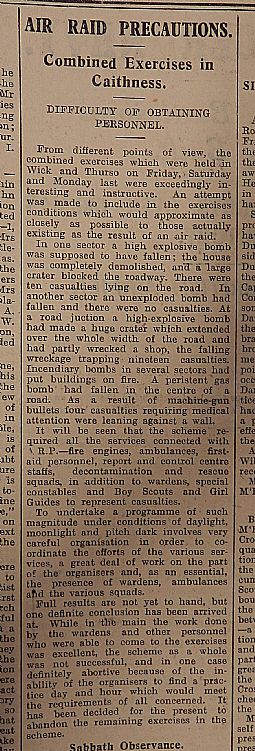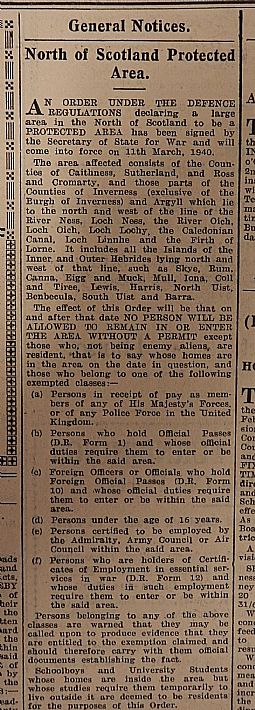Week 26: 26 February – 3 March 1940
On Wednesday 28 February the Soviets launched another major offensive, attacking the Finns along the Mannerheim line. Viipuri, Finland’s second largest city, also came under attack, and the Finns prepared to come to terms. Meanwhile, Hitler directed his generals to start planning a German invasion of Denmark and Norway.
Britain had now been at war for six months. Conscription, rationing and the Blackout had all transformed the way the people of Britain lived their lives; and although British soldiers had not yet been involved in fighting on land, for those serving in the air force and especially the Royal Navy and merchant navy – and their families and friends back home - the war was already being fought in earnest.
![]() As a mournful reminder of this Wick Burgh Council received a letter this week from the Vice-Admiral Commanding Orkneys and Shetlands, “conveying thanks for the arrangements made in connection of the burial of victims of H.M.S. Exmouth” (see Week 22 for details).
As a mournful reminder of this Wick Burgh Council received a letter this week from the Vice-Admiral Commanding Orkneys and Shetlands, “conveying thanks for the arrangements made in connection of the burial of victims of H.M.S. Exmouth” (see Week 22 for details).
![]() Meanwhile the John O’Groat Journal reported the arrival of Newfoundland lumberjacks in the Highlands, “felling trees and astounding the local people by their extraordinary skill in handling the axe”. (Though, as the journalist noted, “Unfortunately, we in Caithness have every need to preserve all the trees we can without reducing their number with the aid of imported experts.”)
Meanwhile the John O’Groat Journal reported the arrival of Newfoundland lumberjacks in the Highlands, “felling trees and astounding the local people by their extraordinary skill in handling the axe”. (Though, as the journalist noted, “Unfortunately, we in Caithness have every need to preserve all the trees we can without reducing their number with the aid of imported experts.”)
 The Air Raid Precautions services of Wick and Thurso combined in a series of training exercises this week, intended to be as realistic as possible by simulating the effects of high explosive, incendiary and persistent gas bombs, as well as wounds caused by machine gun bullets. The only problem was, that not enough people were able to attend to make the exercises worthwhile. The only time when enough people would be available to take part was Sunday afternoon, and “The organising committee realised that while this could be justified on the basis of the whole work being work of necessity and mercy … every effort should be made to avoid the wholesome tradition of Sabbath observance which is characteristic of the county”.
The Air Raid Precautions services of Wick and Thurso combined in a series of training exercises this week, intended to be as realistic as possible by simulating the effects of high explosive, incendiary and persistent gas bombs, as well as wounds caused by machine gun bullets. The only problem was, that not enough people were able to attend to make the exercises worthwhile. The only time when enough people would be available to take part was Sunday afternoon, and “The organising committee realised that while this could be justified on the basis of the whole work being work of necessity and mercy … every effort should be made to avoid the wholesome tradition of Sabbath observance which is characteristic of the county”.
 Finally, notice was given this week that the entire north of Scotland was to be made a “Protected Area” as of 11 March 1940. The area affected was to consist of the counties of Caithness, Sutherland, Ross and Cromarty, parts of Inverness and Argyll, and all the islands of the Hebrides. In future, no one would be allowed to remain in or enter there without a permit. (“Only in this way can the area be adequately protected or safeguarded from enemy opportunities of espionage or other subversive activities”.)
Finally, notice was given this week that the entire north of Scotland was to be made a “Protected Area” as of 11 March 1940. The area affected was to consist of the counties of Caithness, Sutherland, Ross and Cromarty, parts of Inverness and Argyll, and all the islands of the Hebrides. In future, no one would be allowed to remain in or enter there without a permit. (“Only in this way can the area be adequately protected or safeguarded from enemy opportunities of espionage or other subversive activities”.)
Coming soon! Week 27, 4th - 10th March 1940, will be published on Monday 3rd March 2013. To view previous issues please use the menus on the right hand side of the page.
Come and join us on Facebook, let us know what you think about Caithness At War, ask any questions you may have or just say hello! Click on the Facebook icon on the right hand menu to be taken directly to our page.
Comments
As I understand it, there were checks at the main railway stations, such as Inverness, and military police posts on the main roads. If you wanted to travel into or out of the Protected Area you had to have a permit and your national ID card.
Of course, I suppose it would be possible to go across country and slip in that way, but some of the Highlands are so exposed you'd be seen from miles away!
The local police would enforce it too. I don't think every time you saw a policeman you'd have to show your ID, but I expect strangers would be challenged by the police, or people in suspicious circumstances, and if you didn't have either a residency ID or a travel permit you'd be taken in for questioning. Local people didn't police it, but they were expected to report any suspicious behaviour to the authorities for them to check up on.
Boat travel was restricted in the war, because of the U-boats. I doubt if fishermen were challenged coming on or off the boats, but again they'd all be known locally.
Again, as I understand it, it was intended to protect the many secret submarine detecting stations, and radar stations, that were in the Highlands. Places like Dunnet Head had a base, looking out towards Orkney, for instance. As these would be vulnerable targets, and spies were an ever-present fear, the Protected Area was designed to cordon off the north Highlands and make it as secure as possible. (Of course, many people at the time didn't know about the secret installations for obvious reasons, so they naturally objected to the inconvenience!)
But if anyone else knows more, we'd be delighted to hear from them.
Cheers,
Gordon
George




